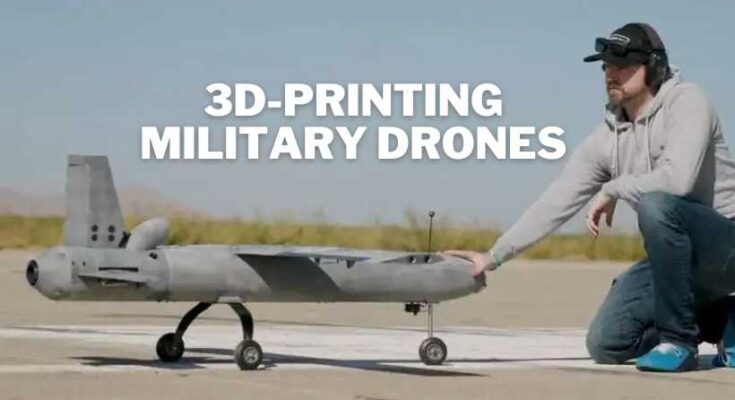Firestorm Labs, a San Diego-based defense startup, has set its sights on revolutionizing military drone production in the midst of Ukraine’s ongoing conflict with Russia.
With $12 million in funding from investors like Lockheed Martin and Pentagon contracts in hand, Firestorm is developing a shipping container-sized drone factory called xCell. This innovative factory can manufacture war-ready drones in less than a day, providing a flexible and efficient solution for Ukraine’s growing demand for drones.
By printing the drone frame and quickly outfitting it with pre-configured components, Firestorm’s technology allows for rapid customization and adaptation to changing mission needs. With plans to produce over 500 drones per month, Firestorm believes that their groundbreaking approach will be crucial in meeting the demands of future wars.
Background
Firestorm Labs is a defense startup that specializes in the production of 3D-printed military drones. With the ongoing war between Ukraine and Russia, there is a pressing need for drones in the military. Firestorm Labs aims to meet this need by utilizing 3D printing technology to quickly and efficiently produce drones for combat situations. Additionally, Firestorm has developed the xCell, a container-sized factory that can be easily deployed to the frontlines of battle. This factory is capable of manufacturing drones in less than a day.
Firestorm’s Factory in San Diego
To support their drone production efforts, Firestorm has recently opened a 15,000 square foot factory in San Diego. This facility serves a dual purpose. It houses the equipment for 3D printing drones and also serves as a production site for the xCell factories that will be deployed to the battlefield. With this factory, Firestorm expects to produce over 500 unmanned machines every month. This production goal is in line with Firestorm’s belief that future wars will require the use of tens of thousands of drones per month.
Venture Capital and Investments
To facilitate the expansion of their manufacturing capacities, Firestorm has successfully obtained substantial financial backing via venture capital investments. As of the present, the organization has amassed $12.5 million in funding, of which Lockheed Martin Ventures has contributed $3 million.
As a result of recognizing the potential of Firestorm’s technology, Lockeed Martin Ventures has invested in the company’s effort to manufacture 3D-printed military drones. The investment provided by Lockheed Martin Ventures will be utilized to expedite the manufacturing process of the xCell factory as well as the Tempest and El Nino drones, which are both capable of undergoing 3D printing in a matter of hours.
Difficulties and Possible Benefits
Firestorm encounters as one of its obstacles the competitiveness of 3D printing technology when applied to mass production. Although 3D printing has demonstrated its efficiency and cost-effectiveness in producing small-scale objects, it has not yet established itself as a viable option for large-scale production.
Nevertheless, the implementation of smaller, geographically dispersed 3D printing stations in decentralized production facilities may increase the likelihood of uninterrupted drone production in the event of potential threats and decrease susceptibility. Firestorm is optimistic that future developments in 3D printing technology will enable larger-scale production to be more efficient.
3D-Printing Military Drones Along The Front Lines Of Ukraine: Firestorm Labs
Agreements and Support
The Department of Defense (DoD) has awarded contracts to Firestorm for the design and production of a modified Tempest drone. The contract, which is valued at $3.8 million, serves as an indication of the Department of Defense’s trust in Firestorm’s capability to provide military drones of superior quality.
Furthermore, Firestorm has entered into an agreement with the Air Force to develop an xCell unit that possesses the capability to manufacture long-range drones. Additionally, they have been incorporated into the Eglin Wide Agile Acquisition Contract, an initiative designed to optimize the procurement process for weaponry for the Department of Defense.
Although Firestorm has not yet been assigned any tasks under this contract, their participation demonstrates the possibility of forthcoming partnerships with the military.
Objectives and Capabilities
Firestorm has established itself as a significant contender in the helicopter manufacturing sector for the Pentagon and its allies. Their primary objective is to develop drones that can function efficiently in environments with congested signals, thereby guaranteeing pilots uninterrupted access to their devices despite the arduous circumstances.
Firestorm asserts that their drones possess a competitive edge in the realm of radar detection avoidance when compared to those of other manufacturers. Firestorm seeks to alter the discourse surrounding the utilization of unmanned systems in combat situations by deploying hundreds of their drones into areas that have historically been inaccessible to them.
Consequences for the Ukraine Conflict
The crisis engulfing Russia and Ukraine provides Firestorm with a favourable circumstance to demonstrate the prowess of their unmanned aerial vehicles. By bolstering the Ukrainian military’s capabilities, these unmanned aerial vehicles may potentially contribute to the conflict. Safety and efficacy concerns are raised regarding the use of drones in combat situations.
Nevertheless, these concerns are alleviated by the technology and expertise of Firestorm, which are Particularly Tailored for Military Uses in the production of drones. Firestorm’s contribution to the defense capabilities of Ukraine has the potential to significantly influence the course of the conflict.
Future Outlook and Prospects
With a forward-looking perspective, Firestorm harbors grand intentions regarding the manufacturing and expansion of drones. Actively pursuing investment opportunities and forming strategic partnerships, they aim to augment their technological prowess and production capacities. The ramifications of the 3D-printed military drones manufactured by Firestorm transcend the Ukraine conflict.
They possess the capacity to fundamentally transform warfare strategies and the defense sector in its entirety. Ensuring sustained investment and advancement in 3D printing technology will be critical for the continued success of Firestorm and for the progression of military drone capabilities.
To conclude,
The 3D-printed military drones developed by Firestorm Labs have far-reaching consequences for the defense sector and forthcoming hostilities. Their utilization of 3D printing technology to rapidly manufacture high-quality drones is a revolutionary development in the realm of military operations.
Firestorm’s ongoing advancements in drone manufacturing and expansion necessitate vigilant monitoring and evaluation of their progress. Ongoing hostilities and the emergence of new threats will inevitably increase the demand for sophisticated military technologies such as Firestorm’s drones.




